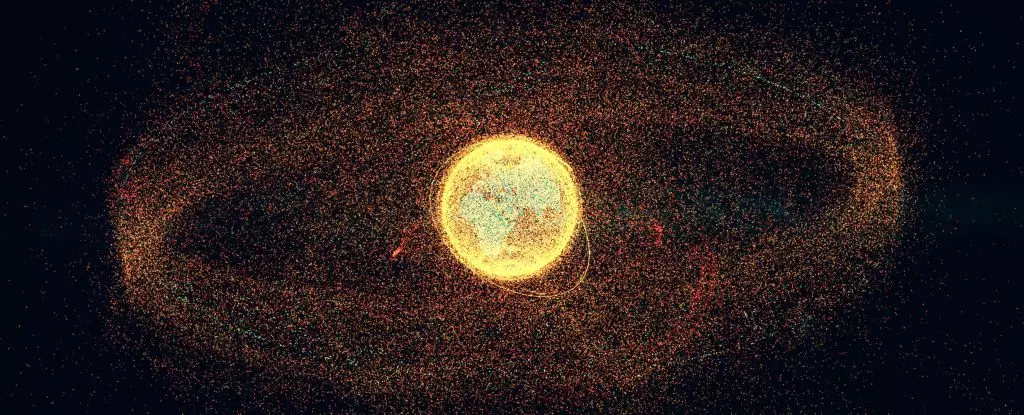In recent years, the issue of debris in Earth’s orbit has escalated from a distant concern to an imminent crisis. This rising tide of space junk, tracked by organizations like the European Space Agency (ESA), reveals the stark reality that our cosmic playground is now littered with thousands of defunct satellites and remnants of disintegrated vehicles. The alarming pace at which we are launching new satellites outstrips the rate at which older ones are retired or removed. As a result, we are on a collision course toward an increasingly hazardous orbital environment, posing risks not only for current operations but for future exploration and innovation.
Space can be thought of as an immense, three-dimensional highway where traffic is governed not just by regulations, but also by the potential for catastrophic encounters. These collisions could set off a catastrophic chain reaction known as the Kessler syndrome. It is a terrifying prospect whereby one collision generates debris that leads to further impacts, thus multiplying the danger to both manned and unmanned missions. Such scenarios, while they might currently seem distant, creep closer with each additional launch we undertake.
A Statistical Reality Check
The statistics surrounding space debris are staggering. ESA estimates suggest there are close to 54,000 objects in orbit exceeding 10 centimeters in size. This figure skyrockets when you account for smaller fragments: approximately 1.2 million pieces between 1 and 10 centimeters, and a staggering 130 million tiny particles ranging from 1 millimeter to 1 centimeter. Each shard not only represents waste; it also embodies a hidden danger, capable of severely damaging operational satellites or critical infrastructures in space, including the International Space Station.
While these figures paint a bleak picture, it’s also crucial to recognize the less obvious contributors to space debris. Non-collisional fragmentation—often resulting from aging spacecraft or unforeseen failures—has now been identified as the largest single source of new debris. Unlike collisions, these fragmentation events are unpredictable, adding yet another layer of complexity in our struggle to mitigate the consequences of space junk. The ESA reported that in 2024 alone, just 11 such incidents generated over 2,600 new debris pieces, reflecting an ongoing issue that requires urgent attention.
Active Measures and Global Responsibility
While the challenges inherent in managing space debris are daunting, we must acknowledge that steps are being made in the right direction. The surge in controlled atmospheric re-entries of old satellites and rocket stages signifies that we are beginning to take responsibility for our space environment. ESA’s commitment to achieving compliance with operational standards demonstrates a recognition of the need for change. Since the mantra for space operations has shifted from “launch and forget” to “launch and manage,” there is a glimmer of hope as more spacecraft are disposed of responsibly.
However, much work remains to be done. The sheer scale of compliance—wherein 90% of rocket bodies in low-Earth orbits vacate valuable orbits in accordance with international norms—illustrates both progress and the enormity of the undertaking. Compliance with even tighter standards must become the norm, fostering a culture of accountability across nations engaged in space activities. The future of space exploration may well depend on our ability to collaborate globally to clean up our cosmic environment.
The Path Forward: Collaborative Solutions for a Safer Orbit
As we recognize the pressing need for debris mitigation strategies, the path forward seems inexorably tied to international collaboration. Just as nations come together to tackle challenges like climate change or pandemics, a united front is paramount for the governance of orbital space. For years, the absence of clear guidelines for the peaceful use of outer space has left rooms for conflicting agendas among countries, businesses, and scientists alike.
Emerging technologies aimed at space debris removal are being developed, but to bring these ideas to fruition, significant funding and cooperative efforts will be necessary. Researchers are exploring solutions ranging from robotic arms for capturing debris, nets, and lasers intended to de-orbit defunct satellites. These innovative approaches could provide respite from the looming threat of space junk, but they require political and financial backing from the global community.
Ultimately, fostering a mindset where the preservation of our orbital environment is a shared responsibility will be crucial for future generations. Rather than merely aiming for compliance with existing standards, we should aspire to innovate, envisioning a sustainable future in space where exploration flourishes unencumbered by the clutter of our past. Humanity’s reach into the cosmos could either reflect our ingenuity or reveal our negligence. The choice will lie in our willingness to act collectively and responsibly.


Leave a Reply